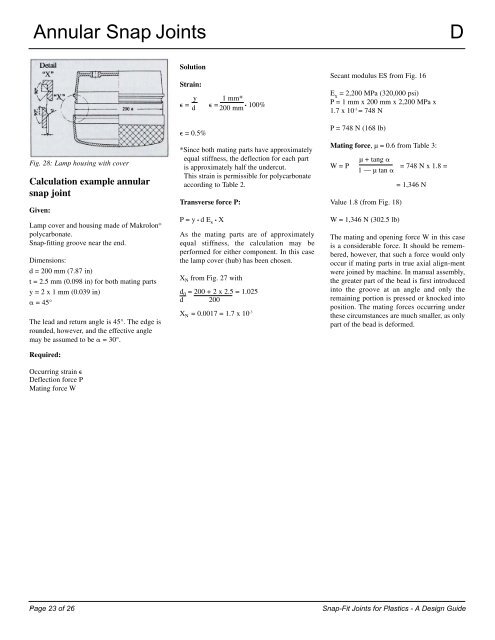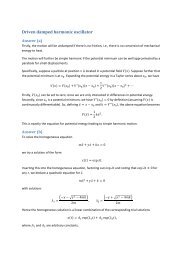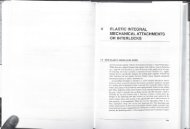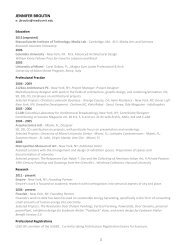Snap-Fit Joints for Plastics - A Design Guide - MIT
Snap-Fit Joints for Plastics - A Design Guide - MIT
Snap-Fit Joints for Plastics - A Design Guide - MIT
Create successful ePaper yourself
Turn your PDF publications into a flip-book with our unique Google optimized e-Paper software.
Annular <strong>Snap</strong> <strong>Joints</strong> D<br />
Fig. 28: Lamp housing with cover<br />
Calculation example annular<br />
snap joint<br />
Given:<br />
Lamp cover and housing made of Makrolon ®<br />
polycarbonate.<br />
<strong>Snap</strong>-fitting groove near the end.<br />
Dimensions:<br />
d = 200 mm (7.87 in)<br />
t = 2.5 mm (0.098 in) <strong>for</strong> both mating parts<br />
y=2x1mm(0.039 in)<br />
� = 45°<br />
The lead and return angle is 45°. The edge is<br />
rounded, however, and the effective angle<br />
may be assumed to be � = 30°.<br />
Required:<br />
Occurring strain �<br />
Deflection <strong>for</strong>ce P<br />
Mating <strong>for</strong>ce W<br />
24<br />
Solution<br />
Strain:<br />
� = y<br />
� = 1 mm* •<br />
d 200 mm<br />
100%<br />
� = 0.5%<br />
*Since both mating parts have approximately<br />
equal stiffness, the deflection <strong>for</strong> each part<br />
is approximately half the undercut.<br />
This strain is permissible <strong>for</strong> polycarbonate<br />
according to Table 2.<br />
Transverse <strong>for</strong>ce P:<br />
P=y• dE s • X<br />
As the mating parts are of approximately<br />
equal stiffness, the calculation may be<br />
per<strong>for</strong>med <strong>for</strong> either component. In this case<br />
the lamp cover (hub) has been chosen.<br />
XN from Fig. 27 with<br />
d0 = 200 + 2 x 2.5 = 1.025<br />
d 200<br />
X N = 0.0017 = 1.7 x 10 -3<br />
Secant modulus ES from Fig. 16<br />
E x = 2,200 MPa (320,000 psi)<br />
P = 1 mm x 200 mm x 2,200 MPa x<br />
1.7 x 10 -3 = 748 N<br />
P = 748 N (168 lb)<br />
Mating <strong>for</strong>ce, µ = 0.6 from Table 3:<br />
W=P<br />
µ + tang �<br />
1—µtan�<br />
Value 1.8 (from Fig. 18)<br />
W = 1,346 N (302.5 lb)<br />
= 748 N x 1.8 =<br />
= 1,346 N<br />
The mating and opening <strong>for</strong>ce W in this case<br />
is a considerable <strong>for</strong>ce. It should be remembered,<br />
however, that such a <strong>for</strong>ce would only<br />
occur if mating parts in true axial align-ment<br />
were joined by machine. In manual assembly,<br />
the greater part of the bead is first introduced<br />
into the groove at an angle and only the<br />
remaining portion is pressed or knocked into<br />
position. The mating <strong>for</strong>ces occurring under<br />
these circumstances are much smaller, as only<br />
part of the bead is de<strong>for</strong>med.<br />
Page 23 of 26 <strong>Snap</strong>-<strong>Fit</strong> <strong>Joints</strong> <strong>for</strong> <strong>Plastics</strong> - A <strong>Design</strong> <strong>Guide</strong>





